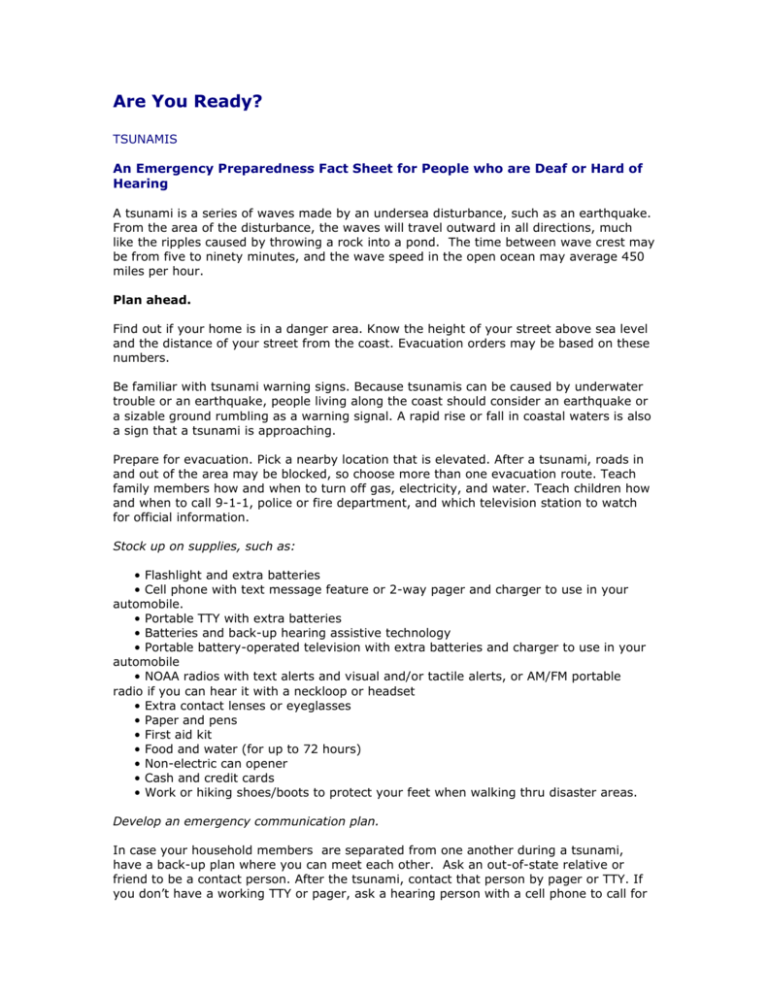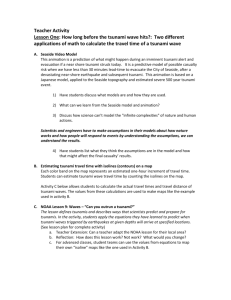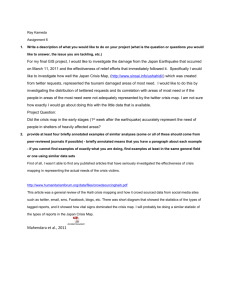
Are You Ready?
TSUNAMIS
An Emergency Preparedness Fact Sheet for People who are Deaf or Hard of
Hearing
A tsunami is a series of waves made by an undersea disturbance, such as an earthquake.
From the area of the disturbance, the waves will travel outward in all directions, much
like the ripples caused by throwing a rock into a pond. The time between wave crest may
be from five to ninety minutes, and the wave speed in the open ocean may average 450
miles per hour.
Plan ahead.
Find out if your home is in a danger area. Know the height of your street above sea level
and the distance of your street from the coast. Evacuation orders may be based on these
numbers.
Be familiar with tsunami warning signs. Because tsunamis can be caused by underwater
trouble or an earthquake, people living along the coast should consider an earthquake or
a sizable ground rumbling as a warning signal. A rapid rise or fall in coastal waters is also
a sign that a tsunami is approaching.
Prepare for evacuation. Pick a nearby location that is elevated. After a tsunami, roads in
and out of the area may be blocked, so choose more than one evacuation route. Teach
family members how and when to turn off gas, electricity, and water. Teach children how
and when to call 9-1-1, police or fire department, and which television station to watch
for official information.
Stock up on supplies, such as:
• Flashlight and extra batteries
• Cell phone with text message feature or 2-way pager and charger to use in your
automobile.
• Portable TTY with extra batteries
• Batteries and back-up hearing assistive technology
• Portable battery-operated television with extra batteries and charger to use in your
automobile
• NOAA radios with text alerts and visual and/or tactile alerts, or AM/FM portable
radio if you can hear it with a neckloop or headset
• Extra contact lenses or eyeglasses
• Paper and pens
• First aid kit
• Food and water (for up to 72 hours)
• Non-electric can opener
• Cash and credit cards
• Work or hiking shoes/boots to protect your feet when walking thru disaster areas.
Develop an emergency communication plan.
In case your household members are separated from one another during a tsunami,
have a back-up plan where you can meet each other. Ask an out-of-state relative or
friend to be a contact person. After the tsunami, contact that person by pager or TTY. If
you don’t have a working TTY or pager, ask a hearing person with a cell phone to call for
you. Be sure each household member knows the name, address, and phone number of
the contact person.
During a tsunami:
Check your pager or the Internet, and watch television to get the latest emergency
information, and be ready to evacuate if asked to do so.
If you hear an official tsunami warning or detect signs of a tsunami, evacuate at once.
Climb to higher ground. A tsunami warning is issued when authorities are certain that a
tsunami threat exists.
Stay away from the beach.
Never go down to the beach to watch a tsunami come in. If you can see the wave you are
too close to escape it.
Return home only after authorities advise it is safe to do so.
A tsunami is a series of waves. Do not assume that one wave means that the danger is
over. The next wave may be larger than the first one. Stay out of the area.
After the tsunami:
Watch television for the latest emergency information.
Help injured or trapped persons. Give first aid where appropriate. Do not move seriously
injured persons unless they are in immediate danger of further injury. Get help.
Return home only when authorities say it is safe.
Enter your home with caution. Use a flashlight when entering damaged buildings. Check
for electrical shorts and live wires. Do not use appliances or lights until an electrician has
checked the electrical system. Open windows and doors to help dry the building. Shovel
mud while it is still moist to give walls and floors an opportunity to dry.
Check food supplies and test drinking water. Fresh food that has come in contact with
flood waters may be dirty and should be thrown out. Have tap water tested by the local
health department.
Check for gas leaks. If you smell gas, open a window and quickly leave the building. Turn
off the gas at the outside main valve if you can and call the gas company from a
neighbor’s home. If you turn off the gas for any reason, it must be turned back on by a
professional.
Look for electrical system damage. If you see sparks or broken or frayed wires, or if you
smell hot insulation, turn off the electricity at the main fuse box or circuit breaker. If you
have to step in water to get to the fuse box or circuit breaker, call an electrician first for
advice.
Check for sewage and water lines damage. If you suspect sewage lines are damaged,
avoid using toilets and call a plumber. If water pipes are damaged, contact the water
company and avoid the water from the tap. You can obtain safe water by melting ice
cubes.
Information adapted from materials by the Federal Emergency Management Agency
(www.fema.gov).
Questions? Comments? Contact the CEPIN Project at:
TDI, 8630 Fenton St. Suite 604, Silver Spring, MD 20910-3822
(301) 589-3006 TTY, (301) 589-3786 Voice, (301) 589-3797 Fax
http://www.tdi-online.org/
· info@tdi-online.org
Or contact one of our regional centers:
CSD of Oklahoma: www.c-s-d.org
DCARA: www.dcara.org
DEAF, Inc.: www.deafinconline.org
NVRC: www.nvrc.org
This project was supported by Cooperative Agreement Number 2004-GT-T4-K008
administered by the U.S. Department of Homeland Security, Office of State and Local
Government Coordination and Preparedness. Points of views or opinions in this document
are those of the author and do not represent the official position or policies of the U.S.
Department of Homeland Security
The CEPIN Project is coordinated by TDI and supported by by Cooperative Agreement Number 2004-GT-T4-K008
administered by the U.S. Department of Homeland Security, Office of Grants and Training. Points of views or
opinions in this document are those of the author and do not represent the official position or policies of the U.S.
Department of Homeland Security.
Copyright © 2006 CEPIN. All Rights Reserved.
Site design by Handsplash Creative Group.










